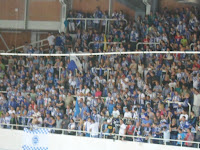 Last night was the opening ceremonies of the 2012 London Olympics. A few years ago, it became tradition to get together with friends to watch the Parade of Nations on TV. Part of the tradition is to serve the local food of the host nation. So I had a few friends over for dinner and TV.
Last night was the opening ceremonies of the 2012 London Olympics. A few years ago, it became tradition to get together with friends to watch the Parade of Nations on TV. Part of the tradition is to serve the local food of the host nation. So I had a few friends over for dinner and TV.
 Some places are easier than other. For the Beijing games, there was Chinese food. Not a big stretch of the imagination. For the Athens games I served Greek food. Again, not a big stretch. Even for the Atlanta games there were fried green tomatoes and BBQ. But what does one serve for English food? Especially when one has to try to come up with English food in the Czech Republic.
Some places are easier than other. For the Beijing games, there was Chinese food. Not a big stretch of the imagination. For the Athens games I served Greek food. Again, not a big stretch. Even for the Atlanta games there were fried green tomatoes and BBQ. But what does one serve for English food? Especially when one has to try to come up with English food in the Czech Republic. Thanks to a few supplies from Nat's last trip to Bristol, I was able to pull it off. Bangers and Mash (sausages with mashed potatoes), Chicken and Vegetable Pie, and Yorkshire Pudding and Onion Gravy. There was even Fish 'n Chips. Well, actually fish sticks and fries but sometimes you just have to get creative. Nat also scored us a bottle of Pimm's Cup for cocktails.
Thanks to a few supplies from Nat's last trip to Bristol, I was able to pull it off. Bangers and Mash (sausages with mashed potatoes), Chicken and Vegetable Pie, and Yorkshire Pudding and Onion Gravy. There was even Fish 'n Chips. Well, actually fish sticks and fries but sometimes you just have to get creative. Nat also scored us a bottle of Pimm's Cup for cocktails. Pimm's No. 1 Cup is a reddish, gin based spirit that has a spiced citrus taste to it. We drank it "English-style", mixed with lemonade, and pieces of cucumber, apples and oranges. Quite refreshing.
Pimm's No. 1 Cup is a reddish, gin based spirit that has a spiced citrus taste to it. We drank it "English-style", mixed with lemonade, and pieces of cucumber, apples and oranges. Quite refreshing.London is one hour behind Central European Time so the TV broadcast didn't begin until 9 PM. Watching on Czech TV was OK but I really would have preferred English-language commentary. Oh well. The Brits put on one heck of a show.
 One of the funniest things from the broadcast was when the Czech athletes came out during the Parade of Nations. In keeping with Czech humor, the Czechs marched out in Wellies and carrying brollies. British English - Wellingtons are rain boots and a brolly is an umbrella.
One of the funniest things from the broadcast was when the Czech athletes came out during the Parade of Nations. In keeping with Czech humor, the Czechs marched out in Wellies and carrying brollies. British English - Wellingtons are rain boots and a brolly is an umbrella. Good luck to all of the American and Czech athletes competing in the Olympics. I love that when my parents watch the Olympics on TV, if an American isn't competing, then they always cheer for the Czechs.
Update: Those Wellies were a big hit. Apparently, they were so popular that they quickly sold out in London.











.jpg)
.jpg)
.jpg)
.jpg)
.jpg)
.jpg)

.jpg)
.jpg)
.jpg)

.jpg)

.jpg)
.jpg)
.jpg)
.jpg)

.jpg)
.jpg)
.jpg)
.jpg)
.jpg)
.jpg)
.jpg)
.jpg)
.jpg)

.jpg)
.jpg)
.jpg)

.jpg)
.jpg)



























